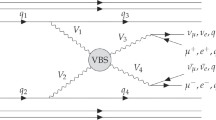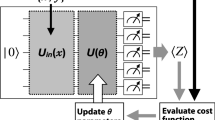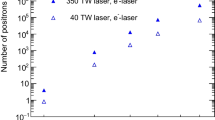Abstract
In collider physics experiments, particle identification (PID), i.e., the identification of the charged particle species in the detector is usually one of the most crucial tools in data analysis. In the past decade, machine learning techniques have gradually become one of the mainstream methods in PID, usually providing superior discrimination power compared to classical algorithms. In recent years, quantum machine learning (QML) has bridged the traditional machine learning and the quantum computing techniques, providing further improvement potential for traditional machine learning models. In this work, targeting at the \(\mu ^{\pm } /\pi ^{\pm }\) discrimination problem at the BESIII experiment, we developed a variational quantum classifier (VQC) with nine qubits. Using the IBM quantum simulator, we studied various encoding circuits and variational ansatzes to explore their performance. Classical optimizers are able to minimize the loss function in quantum-classical hybrid models effectively. A comparison of VQC with the traditional multiple layer perception neural network reveals they perform similarly on the same datasets. This illustrates the feasibility to apply quantum machine learning to data analysis in collider physics experiments in the future.







Similar content being viewed by others
Data availability
The data used in the paper is within the BESIII collaboration, which is not available in public repositories. However, all data used in the paper can be made available from the corresponding author on reasonable request.
References
M. Ablikim, Z. An, J. Bai, N. Berger, J. Bian, X. Cai, G. Cao, X. Cao, J. Chang, C. Chen et al., Design and construction of the Besiii detector. Nucl. Instrum. Methods Phys. Res., Sect. A 614(3), 345–399 (2010). https://doi.org/10.1016/j.nima.2009.12.050
A. Radovic, M. Williams, D. Rousseau, M. Kagan, D. Bonacorsi, A. Himmel, A. Aurisano, K. Terao, T. Wongjirad, Machine learning at the energy and intensity frontiers of particle physics. Nature 560(7716), 41–48 (2018). https://doi.org/10.1038/s41586-018-0361-2
M. Feickert, B. Nachman, A living review of machine learning for particle physics. arXiv preprint arXiv:2102.02770 (2021) 10.48550/arXiv.2102.02770
B.P. Roe, H.-J. Yang, J. Zhu, Y. Liu, I. Stancu, G. McGregor, Boosted decision trees as an alternative to artificial neural networks for particle identification. Nucl. Instrum. Methods Phys. Res. Sect. A 543(2–3), 577–584 (2005). https://doi.org/10.1016/j.nima.2004.12.018
C.M. Bishop et al., Neural Networks for Pattern Recognition (Oxford University Press, New York, 1995)
J. Biamonte, P. Wittek, N. Pancotti, P. Rebentrost, N. Wiebe, S. Lloyd, Quantum machine learning. Nature 549(7671), 195–202 (2017). https://doi.org/10.1038/nature23474
M. Schuld, F. Petruccione, Supervised Learning with Quantum Computers, vol. 17 (Springer, Berlin, 2018)
W. Guan, G. Perdue, A. Pesah, M. Schuld, K. Terashi, S. Vallecorsa, J.-R. Vlimant, Quantum machine learning in high energy physics. Machine Learn. Sci. Technol. 2(1), 011003 (2021). https://doi.org/10.1088/2632-2153/abc17d
S.L. Wu, S. Yoo, Challenges and opportunities in quantum machine learning for high-energy physics. Nat. Rev. Phys. 4(3), 143–144 (2022)
P. Rebentrost, M. Mohseni, S. Lloyd, Quantum support vector machine for big data classification. Phys. Rev. Lett. 113(13), 130503 (2014). https://doi.org/10.1103/PhysRevLett.113.130503
M. Schuld, A. Bocharov, K.M. Svore, N. Wiebe, Circuit-centric quantum classifiers. Phys. Rev. A 101(3), 032308 (2020). https://doi.org/10.1103/PhysRevA.101.032308
S.L. Wu, S. Sun, W. Guan, C. Zhou, J. Chan, C.L. Cheng, T. Pham, Y. Qian, A.Z. Wang, R. Zhang et al., Application of quantum machine learning using the quantum kernel algorithm on high energy physics analysis at the lhc. Phys. Rev. Res. 3(3), 033221 (2021). https://doi.org/10.1103/PhysRevResearch.3.033221
V. Belis, S. González-Castillo, C. Reissel, S. Vallecorsa, E.F. Combarro, Dissertori,G., Reiter,F.: Higgs analysis with quantum classifiers. In: EPJ Web of Conferences, vol. 251, p. 03070 (2021). 10.1051/epjconf/202125103070
V. Havlíček, A.D. Córcoles, K. Temme, A.W. Harrow, A. Kandala, J.M. Chow, J.M. Gambetta, Supervised learning with quantum-enhanced feature spaces. Nature 567(7747), 209–212 (2019). https://doi.org/10.1038/s41586-019-0980-2
P.-T. De Boer, D.P. Kroese, S. Mannor, R.Y. Rubinstein, A tutorial on the cross-entropy method. Ann. Oper. Res. 134(1), 19–67 (2005). https://doi.org/10.1007/s10479-005-5724-z
W.C. Davidon, Variable metric method for minimization. SIAM J. Optim. 1(1), 1–17 (1991). https://doi.org/10.1137/0801001
A.G. Baydin, B.A. Pearlmutter, A.A. Radul, J.M. Siskind, Automatic differentiation in machine learning: a survey. J. Machine Learn. Res. 18, 1–43 (2018)
V. Bergholm, J. Izaac, M. Schuld, C. Gogolin, M.S. Alam, S. Ahmed, J.M. Arrazola, C. Blank, A. Delgado, S. Jahangiri, et al.: Pennylane: automatic differentiation of hybrid quantum-classical computations. arXiv preprint arXiv:1811.04968 (2018) 10.48550/arXiv.1811.04968
M. Schuld, V. Bergholm, C. Gogolin, J. Izaac, N. Killoran, Evaluating analytic gradients on quantum hardware. Phys. Rev. A 99(3), 032331 (2019). https://doi.org/10.1103/PhysRevA.99.032331
R.-G. Ping, Event generators at Besiii. Chin. Phys. C 32(8), 599–602 (2008). https://doi.org/10.1088/1674-1137/32/8/001
W.-D. Li, H.-M. Liu, Z. Deng, K. He, M. He, X. Ji, L. Jiang, H. Li, C. Liu, Q. Ma, et al.: The offline software for the besiii experiment. In: Proceeding of CHEP, vol.27 (2006)
W. Blum, W. Riegler, L. Rolandi, Particle Detection with Drift Chambers (Springer, Berlin, 2008)
C. Zhu, R.H. Byrd, P. Lu, J. Nocedal, Algorithm 778: L-BFGS-B: Fortran subroutines for large-scale bound-constrained optimization. ACM Trans. Math. Softw. (TOMS) 23(4), 550–560 (1997). https://doi.org/10.1145/279232.279236
Acknowledgements
This work was supported by National Natural Science Foundation of China (NSFC) under Contracts Nos. 12025502, 12105158, 12188102.
Author information
Authors and Affiliations
Corresponding author
Rights and permissions
Springer Nature or its licensor (e.g. a society or other partner) holds exclusive rights to this article under a publishing agreement with the author(s) or other rightsholder(s); author self-archiving of the accepted manuscript version of this article is solely governed by the terms of such publishing agreement and applicable law.
About this article
Cite this article
Yao, Z., Huang, X., Li, T. et al. Muon/pion identification at BESIII based on variational quantum classifier. Eur. Phys. J. Plus 139, 356 (2024). https://doi.org/10.1140/epjp/s13360-024-05144-9
Received:
Accepted:
Published:
DOI: https://doi.org/10.1140/epjp/s13360-024-05144-9




